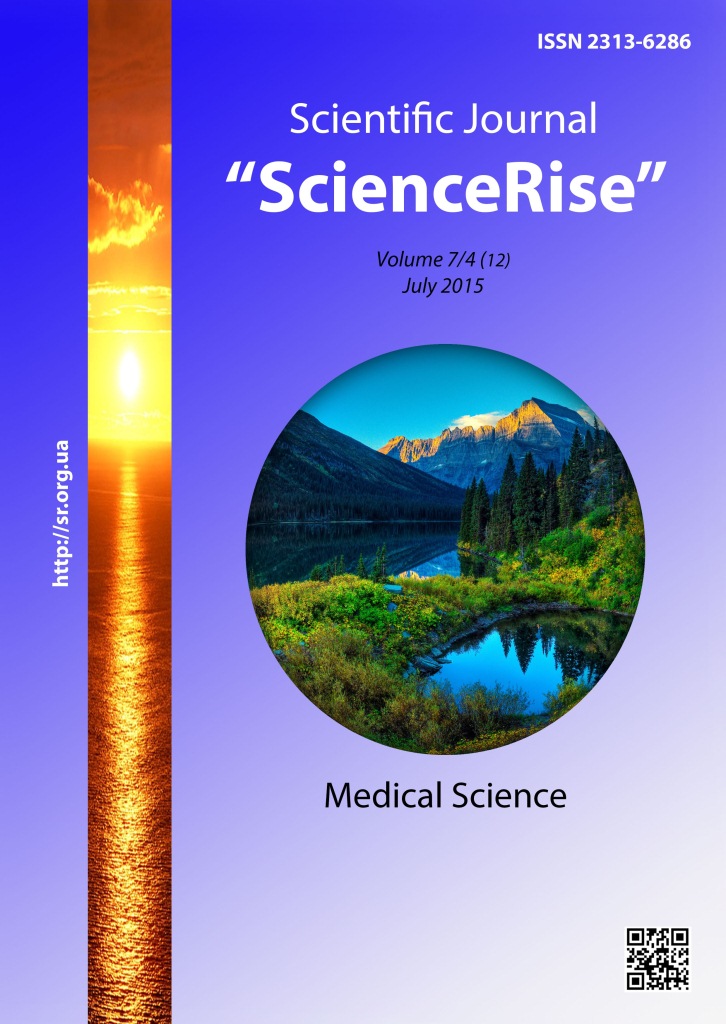Peculiarities of intensive care at destructive pneumonias in children
DOI:
https://doi.org/10.15587/2313-8416.2015.47391Keywords:
child, bacterial pneumonia, intensive care, microorganism, pneumococcus, bronchoscopy, thoracoscopy.Abstract
In spite of success in treatment and diagnostics attained last years the problem of an acute pneumonia remains actual, this fact is caused by the growing rate of prolonged clinical course and unfavorable clinical outcomes. The growth of antibiotic resistance of microflora is a substantial problem. In addition even the most vigorous modern antibacterial preparations are not effective without an adequate surgical sanitation of the nidus of infection.
The aim of the work is to improve the therapy of destructive pneumonia in children that need an intensive care.
Methods. 12 patients 9 month – 12 years old who underwent the treatment of heavy community-acquired pneumonia were under observation. There was carried out an X-ray examination at admission and in dynamics, microbiological examination of lavages from the respiratory tract, pleural exudate and blood, determination of laboratory indexes of intoxication (by Kalf-Kalif, Dashtayants, Lubimova) and the level of the middle molecules. The statistical analysis was done using the program package "Microsoft Excel" and "StatSoft 6".
Results. In the course of microbiological examination it was demonstrated the prevalence of gram-negative flora and its associations with gram-positive one, the purely gram-positive flora was detected only in 25 % of children. So there was proved an inefficiency of antibiotics that effect mainly on the gram-positive microorganisms. In addition the cephalosporins of the third generation were found insufficiently effective. Such preparations as carbapenems or protected penicillins were chosen in vitro and according to its clinical efficiency. Plasmapheresis and bronchoscopy are useful in the complex therapy. Thoracoscopy must be carried out if the conservative treatment is not effective
Conclusions. At present the gram-negative flora and its associations with gram-positive one prevails in etiological structure of the heavy community-acquired pneumonias that must be taken into account choosing the start preparations for empirical therapy. In the cases of insufficient efficiency of conservative therapy an active surgical tactics must be used.
References
Lassi, Z. S., Imdad, A., Bhutta, Z. A. (2015). Short-course versus long-course intravenous therapy with the same antibiotic for severe community-acquiredpneumonia in children aged two months to 59 months. Cochrane Database Syst Rev. – Available at: http://www.ncbi.nlm.nih.gov/pubmed/26077639 doi: 10.1002/14651858.CD008032.pub2
Nudga, A. N., Kovalyova, E. A., Galinskaya, V. A., Sidorenko, O. A., Ponomarenko, A. I. (2006). Hard Pneumonias with Fatal Outcome (Analysis, Course, Features). Meditsina Neotlozhnykh Sostoyanij, 5 (6). – Available at: http://www.mif-ua.com/archive/article_print/945
Mendes, R. E., Hollingsworth, R. C., Costello, A., Jones, R. N., Isturiz, R. E., Hewlett, D., Farrell, D. J. (2015). Non-invasive Streptococcus pneumoniae serotypes recovered from hospitalized adult patients in the United States (2009-2012). Antimicrobial Agents and Chemotherapy, AAC.00182–15. – Available at: http://www.ncbi.nlm.nih.gov/pubmed/26124173. doi: 10.1128/aac.00182-15
Marimón, J. M., Morales, M., Cilla, G., Vicente, D., Pérez-Trallero, E. (2015). Detection of bacteria and viruses in the pleural effusion of children and adults with community-acquired pneumonia. Future Microbiology, 10 (6), 909–915. doi: 10.2217/fmb.14.143
Jroundi, I., Mahraoui, C., Benmessaoud, R., Moraleda, C., Benjelloun, B., Bassat, Q. (2015). Knowledge gaps on paediatric respiratory infections in Morocco, Northern Africa. Archives of Public Health, 73 (1), 28. doi: 10.1186/s13690-015-0076-x
Shabalov, N. P. (2003). Pneumonias in Young Age Children. Lechaschij Vrach, 2. – Available at: http://www.lvrach.ru/2003/02/4530038
Kozlov, R. S., Stetsyuk, O. U., Andreeva, I. V. (2007). Contemporary Trends of Antibiotic Resistance of Nosocomial Infection Exciters in Russia ICU: What is waiting for Us Further? Intensivnaya terapiya, 4. – Available at: http://www.icj.ru/2007-04-01.html
Williams, D. J., Edwards, K. M., Self, W. H., Zhu, Y., Ampofo, K., Pavia, A. T., Grijalva, C. G. (2015). Antibiotic Choice for Children Hospitalized With Pneumonia and Adherence to National Guidelines. PEDIATRICS, 136 (1), 44–52. doi: 10.1542/peds.2014-3047
Zhang, Y., Chen, Y., Chen, Z., Zhou, Y., Sheng, Y., Xu, D., Wang, Y. (2014). Effects of Bronchoalveolar Lavage on Refractory Mycoplasma pneumoniae Pneumonia. Respiratory Care, 59 (9), 1433–1439. – Available at: http://www.ncbi.nlm.nih.gov/pubmed/24962224. doi: 10.4187/respcare.03032
Zuo Y., Yang Y., Hong J., Wu Z., Yu L., Tao J., Gong S. (2014). Analysis on diagnosis and treatment of 15 cases with severe influenza A. Zhonghua Er Ke Za Zhi, 52 (2), 142–145. – Available at: http://www.ncbi.nlm.nih.gov/pubmed/24739728
Downloads
Published
Issue
Section
License
Copyright (c) 2015 Марина Александровна Макарова

This work is licensed under a Creative Commons Attribution 4.0 International License.
Our journal abides by the Creative Commons CC BY copyright rights and permissions for open access journals.
Authors, who are published in this journal, agree to the following conditions:
1. The authors reserve the right to authorship of the work and pass the first publication right of this work to the journal under the terms of a Creative Commons CC BY, which allows others to freely distribute the published research with the obligatory reference to the authors of the original work and the first publication of the work in this journal.
2. The authors have the right to conclude separate supplement agreements that relate to non-exclusive work distribution in the form in which it has been published by the journal (for example, to upload the work to the online storage of the journal or publish it as part of a monograph), provided that the reference to the first publication of the work in this journal is included.

